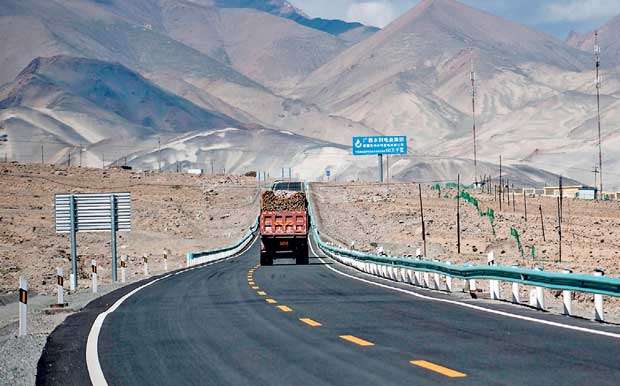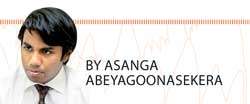22 Jan 2019 - {{hitsCtrl.values.hits}}

 In the new year, Sri Lanka remains at a crossroads. As before, the island nation requires carefully calibrated statecraft from policymakers to choose the path towards prosperity. The political, constitutional and parliamentary crisis over the last months of 2018 was a waste of time. Possibly, the president never was fully in control of the crisis-riddled turbulent political alliance strategized by him.
In the new year, Sri Lanka remains at a crossroads. As before, the island nation requires carefully calibrated statecraft from policymakers to choose the path towards prosperity. The political, constitutional and parliamentary crisis over the last months of 2018 was a waste of time. Possibly, the president never was fully in control of the crisis-riddled turbulent political alliance strategized by him.
More Machiavellian than over his appointment, a lightning strike introduced a model, which was a legally proven impossibility. What came out of it was that the president should be consulted in national affairs. In the months ahead, the polity will decide which road to take, casting their ballot from local election to parliament and finally, the presidential by 2020.
External influences play a pivotal role in statecraft. Two roads ahead are shaped by external forces. Perhaps, these roads can be seen as diverting at a point to a perhaps simplistic East-West binary. It is also visible in internal polarizations of nations. Western or Chinese influence is the case in Sri Lanka but this debate and international tug extends far beyond the island nation. International relations and its effects to the nations should be understood by time, space and scale.
There are moments in history when the natural order is disturbed by leaders, breaking the natural patterns, doing the impossible, mobilizing and bringing the people together to achieve the space and scale imagined by the leader. Such was the moment in 331 BC, in the dusty plains of Gaugamela, a town near Iraqi Kurdistan, which changed history.
According to Plutarch, the young General Alexander was sleeping so deeply that his commanders had to shake him awake before the battle. Dressed in his favoured outfit, with a bright helmet made from most refined silver, grasping a trusted sword in his right hand, he led his troops to a crushing victory, defeating Darius III’s vastly superior Persian Empire.
The moment opened the West to the East a moment of confluence of Western and Eastern cultures and values, touching the Silk Road, explained Peter Frankopan. Alexander was the first to bring a sweeping approach with gigantic scale, reaching distant Asian space embracing the richness of Asia, reaching the value of Silk Road. He respected the cultures and even his defeated enemies marching towards Hindu Kush, which time was the only factor that caught in-between achieving space and scale of his ambition, a death at a young age of 32.
The empire he built was scattered after his time. A powerful will of a great and strong man may bring grand visions but time will capture and recalibrate putting back as explained by the German geopolitical thinker Karl Haushofer: “sinked back to its accustomed ways: its lasting earth-bound traits will eventually win out”.
US power
This is applicable to all the empires, including the modern-day superpower the United States; the nation is now undergoing withdrawal of its troops from Syria, Iraq and Afghanistan. The scale and space of the US power built in the past had to be reduced with time as the economic slowdown and massive spending to sustain the geographical spaces captured for power projection.
While the US is trying to sustain its exiting spaces and retain the power projection, it had a decade ago another Asia power. China is seen gaining momentum of building its own empire with its own characteristics. For the US, it was a massive effort to capture the central artery of Asia, the Silk Road across the two oceans of Atlantic and Pacific, setting up bases, listening posts, trade hubs and allies. The US does not wish to play the global policeman utters Donald Trump borrowing from President Kennedy, who explained the US position during the cold war.
The US is busy recalibrating and rechristening its versions from Asia Pacific to Indo Pacific to regain and sustain its geopolitical space. What we see is withdrawal and pulling out from the central artery of Asia, the Silk Road.
The quadruple alliance with India, the US, Japan and Australia, is another form of christening to emphasise the likeminded allies should look elsewhere. India, an emerging South Asian power, should realign its position with its Asian rising and expanding power China rather than counting on the US, which has a withdrawal strategy.
Sri Lanka sitting at a crossroads between the two powers is to have a balanced approach. However, more than balancing, it goes off balance, due to its internal political disarray. Like all other empires, the One Belt One Road Initiative (OBOR) scale is massive. Could this be achieved or will it slow down and scale back?
Dr. Françoise Nicolas from FRS, a leading French think tank, at a recent Colombo Shangri-La colloquium held by Sri Lanka’s security think tank, said the OBOR is a “systemic project and a strategic plan rather than an “initiative”.
There are three possible scenarios, which could unfold. First, the project develops and succeeds in promoting a new form of globalization, which is gradually referred to: new globalization with Chinese characteristics (or Alibaba world). Second, the project develops but is faced with increasing resistance and problems and thus gradually slows down. The third scenario is the OBOR develops successfully, although not perfectly smoothly and it is in conflict with other forms of globalization, leading to the emergence of two rival poles, one led by the US and the other by China, each one with its own infrastructural networks.
Need of year
Going back to geopolitical thinker who clearly understood the importance of the island Japan’s geography in the Pacific, Dr. Karl Haushofer explained in 1925, “Powerful new states emerged because their creators, with the sensitivity of the true statesman, understood the geopolitical demands of the hour. Without such insight, violence and arbitrariness would have charted the course of history. Nothing with lasting value could have been created. All structures of state, which might have been created, would sooner or later have crumbled into dust and oblivion before the eternal forces of soil and climate.”
If China fails to understand the geopolitical demands of the hour, it would fail to achieve its grand OBOR strategy.
Given this scenario and the grand project spelled out by rising China, what effects does a nation like Sri Lanka have from global power transition?
There are several. First, internal polarization of political parties and society between the two camps, the third scenario explained before. This could also lead to internal political instability. Second, economic projects from China and the West, demanding for strategic assets and investment to secure the sphere of influence in the island. Some nations prefer to play one against the other to demand better economic offers.
Regionally, the internal political instability during last few months in Sri Lanka has cost the nation’s economy deeply. The recent parliament elections in Bangladesh with Prime Minister Sheikh Hasina’s clear majority victory is a sign of political stability to sustain the economic growth of last quarter (2018) at 7.6 percent GDP, compared to Sri Lanka. With its recent political instability, Sri Lanka would find it challenging to sustain or improve from its last year’s economic growth of below 4 percent.
Balancing the global and the local, the need of the year is to keep building and strengthening internal policies in small nations such as Sri Lanka.
(Asanga Abeyagoonasekera, author of ‘Sri Lanka at Crossroad, Geopolitical Challenges and National Interests’ (2019), is Director General of the National Security Think Tank of Sri Lanka, under the Defence Ministry. The views expressed here are his own)
16 Nov 2024 23 minute ago
16 Nov 2024 40 minute ago
16 Nov 2024 1 hours ago
15 Nov 2024 15 Nov 2024
15 Nov 2024 15 Nov 2024